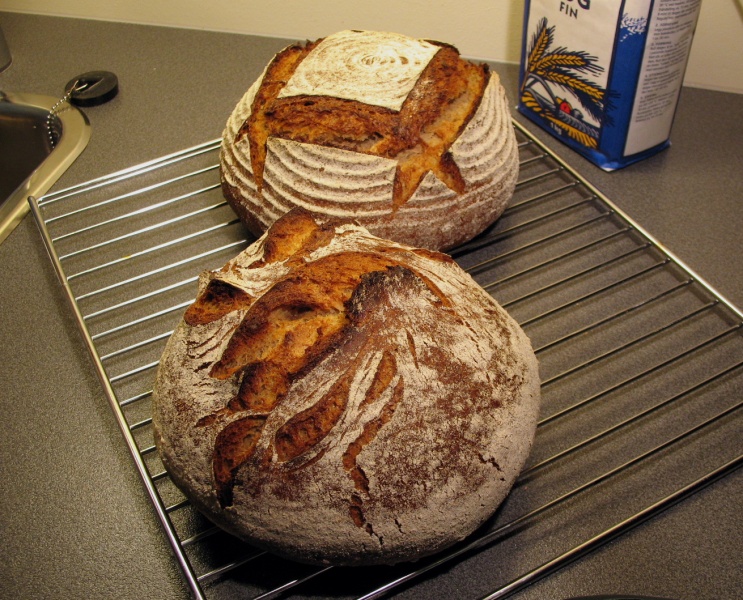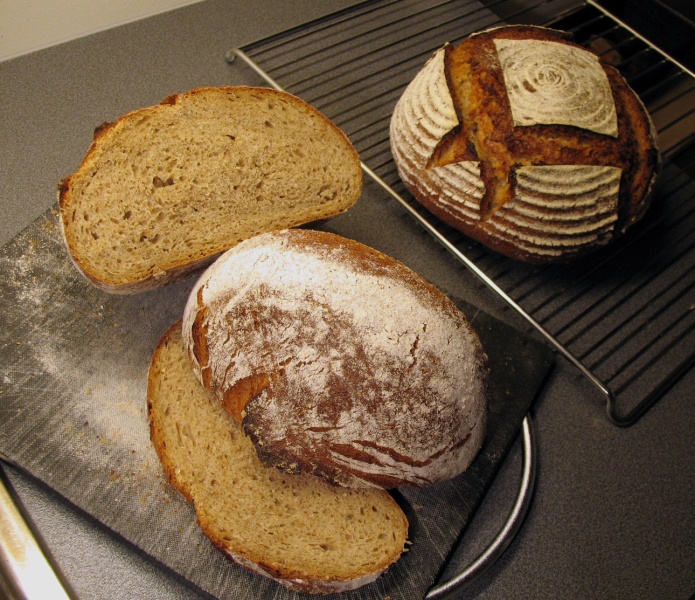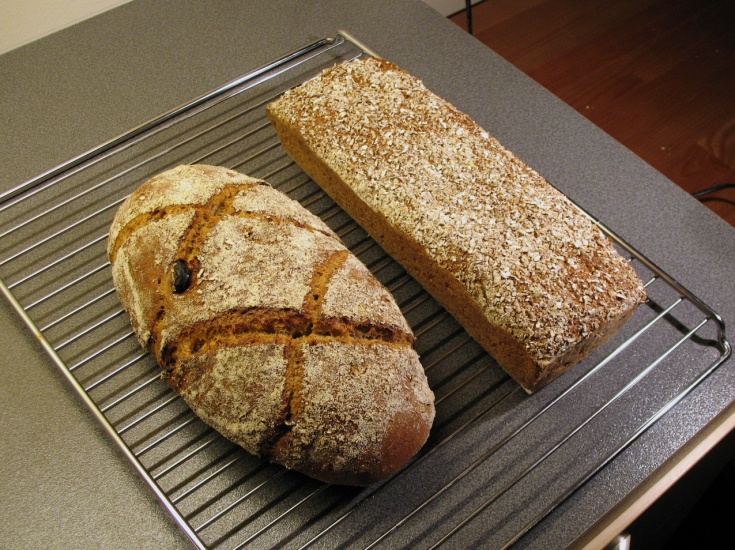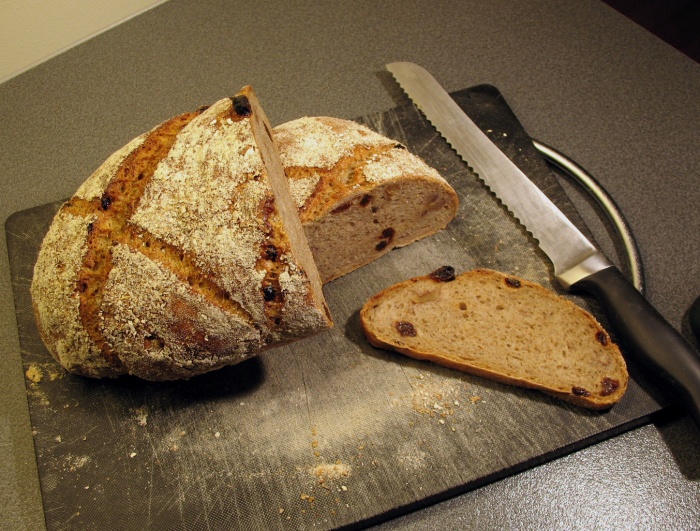
Catcher in the rye
Everyone's got a little Holden Caulfield in them, I presume?
I thought I should put up some of the recent loaves I've baked, and first are two 40% rye boules that are loosely based on Hamelman's flaxseed rye with old bread soaker. David, Eric and myself loved the original recipe, and David put up a detailed breakdown of it on his blog (by the way, reading through David's blog entry again, I believe that the blog entry should list fresh yeast, not instant). This time, I wanted to combine the complex flavour of the stale bread soaker and acidity of the sourdough with something sweet. I have a hopeless, irrepairable sweet tooth, so that's why!
The sweetness I had in mind was something along the lines of the classic Borodinsky rye. I've made some Borodinskies before, and I've found a combination of coriander seeds, honey and barley malt extract to be truly divine. So, I started with Hamelman's recipe for the flaxseed rye, and a) omitted the flax altogether, and b) reduced the overall hydration to 70%. Then, c) added 1% coarsely crushed coriander seeds, and d) 3% honey and 3% barley malt extract. I also omitted the (optional) seed coating mentioned in Hamelman's formula.
I shaped two 1kg boules, and let one proof as usual in a brotform, and let the other proof seam side down. Due to honey and barley malt extract, I watched the dough carefully during final proof, and found that 45 - 50 mins. was sufficient for my dough. I also found that the crust quickly gained colour during the bake (also due to honey and the malt extract), so I reduced the temperature a bit quicker than usual. I ended up with 250dC the first 10 mins. (with steam) and then gradually lowered the temperature towards 205dC for 35 mins. more. Total baking time approx. 45 mins. I wanted a dark, thick crust, a deep, nutty brown colour, that will enhance the overall aroma of the loaves. So if you want to try it, don't shy away from giving it a full bake, but do watch it. You want nutty brown, not charcoal black :)


A friend of mine requested a Vollkornbrot, so I baked him the one from "Bread", shown on below on the right. No crumb shot unfortunately... but he said it satisfied his Vollkorn cravings, so I take that as a good sign. Below on the left is Hamelman's sourdough rye with raisins and walnuts. Sweet tooth again, I know...

I shaped it as a "viverais": This shape is shown in Suas' ABAP, and on p. 13 in this .pdf. You shape it into a batard and (yes, this step had me hesitating a few seconds - mangling that pretty batard...) divide it in seven pieces by cutting two X's in the dough. Pretty harsh treatment, I agree, but the loaf did recover some during final proof, and the separated pieces baked together nicely in the oven. It produced an appealing, rustic look, I think!
PS: A slice of this is a perfect match for goat cheese.



Comments
That's a new concept for me, Hansjoakim. What is the intent behind this approach? If the parts merge together during the final proof and bake, does it have more or less the same effect as slashing? Some other reason, maybe?
You definitely have a way with rye, as evidenced yet again by these breads.
Thanks,
Paul
Hi Paul, and thanks! :)
I'm not sure if there is any special reasoning behind the viverais other than to make a loaf that looks a bit unusual and eyecatching. It serves a similar purpose as slashing, but contrary to usual slashes, the viverais cuts are more distinct and go all the way down the side of the loaf. I wouldn't do this shaping on fragile whole-grain loaves, but country style breads (such as the raisin+walnut rye, which is only 35% rye) can take it.
I think the idea behind this shape (besides making it look good) is that it allows expansion because the loaf isn't slashed. There's a similar shape called a Charlseton (in picture) that has the same two X's but instead of cutting them you mash then down with a dowel and flour them so they don't disapper when proofing and baking. They seem to give the loaf room to expand without blowing out while baking.
By the way, did you use the top on your pullman pan when you baked the volkornbrot? I just got one my birthday and I'm almost ready to put a loaf of Hamelman volkornbrot in the oven. I haven't decided whether or not to put the lid on. Since the dough is almost up to the top of the pan already I'm leaning toward leaving it off.
And great pictures, as usual!
Thanks for including that PDF - I saved a copy of it.
hansjoakim,
They are all quite beautiful as usual. I continue to be shocked at the natural elegance of the "seam side up" loaves you produce. Side by side, the slashed boule while text book perfect looks slightly contrived. The motion and energy that is evident is artistic to the extreme, in my opinion. I really think you are on to something here. Quite remarkable!
Eric
chouette: Thanks! And, yes, have a look at the .pdf. It's nice to have something like that for inspiration when shaping ordinary loaves or even smaller ones.
Eric: Thank you so much :) And I do agree with you. The "ordinary" boule looks somewhat restrained compared to the exciting appearance of the seam side up boule. There is something about rye doughs that make them great for this kind of baking - I find it difficult to make really attractive rye loaves with ordinary slashing (they tend to look... messy, somehow, cracks and stuff going on in places other than the slashed cuts), while the seam side up gives off a more dramatic appearance. Another advantage of this technique, is that it doesn't really matter if you slightly underproof it. An underproofed slashed loaf always gets nasty blowouts in my kitchen; that's nothing to worry about with the seam side up.
Gorgeous loaves and I would love a taste. The coriander addition with the honey and barley malt syrup sounds devine. I have to admit I haven't used my coriander seeds/ground that much...they have a such a nice and different flavor..lemonish...mild.....well this brings to mind very different but how I love the pungent cilantro fresh. I just cleaned out and organized my spice cupboard..hummm coriander!
Sylvia
In both your title and your bread, Hans. It's been a while since I read Salinger. Will have to dust it off and enjoy it again.
The viverais is interesting. I'm amazed that the dough reunites itself so strongly after being cut apart.
The seam-side-down look is beautiful. Will have to give that a try. It certainly will eliminate my scoring mistakes!
weavershouse
Thanks :)
gcook17: What a lovely loaf you've got there! I baked the Vollkornbrot in a regular bread tin with no cover. I'm one of those who still doesn't own a proper pullman pan... )-; I hope your VK turned out well!
Regarding my write-up of the rye with altus: I wrote what I did. I used instant yeast.
One of these days, I am going to try fresh yeast. I've never used it.
David
Ah, I see. Reading Hamelman's original recipe again, I see he lists "Yeast" without specifying what kind. Since his formula is intended for bakeries, I suppose he means fresh or commercial yeast. I'm not sure if there's any detectable differences between the yeast products, but one should probably reduce the amount of yeast by a third when switching from fresh to instant yeast.